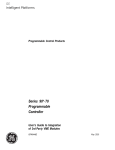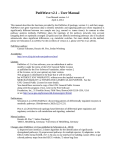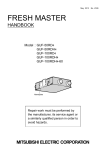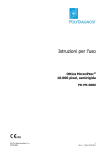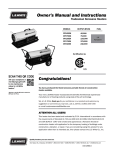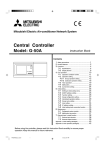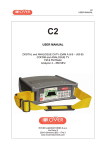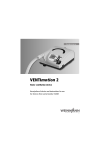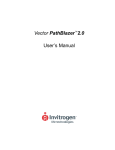Download Dimplex Ec-eau Technical data
Transcript
A Class Heat Pump Cylinders Up to 250L EC-Eau Cylinder Range Installation and User Instructions Important - This manual must be left with the user after Installation! Benchmark places responsibilities on both manufacturers and installers. The purpose is to ensure that customers are provided with the correct equipment for their needs, that it is installed, commissioned and serviced in accordance with the manufacturer’s instructions by competent persons and that it meets the requirements of the appropriate Building Regulations. The Benchmark Checklist can be used to demonstrate compliance with Building Regulations and should be provided to the customer for future reference. Installers are required to carry out installation, commissioning and servicing work in accordance with the Benchmark Code of Practice which is available from the Heating and Hot Water Industry Council who manage and promote the Scheme. Visit www.centralheating.co.uk for more information. A Class HP Installation and User Instructions R02583-2 09/13 Page 2 Dimplex is a licensed member of the Benchmark Scheme which aims to improve the standards of installation and commissioning of domestic heating and hot water systems in the UK and to encourage regular servicing to optimise safety, efficiency and performance. 0 Overall View 08 02 03 07 06 01 05 04 Figure 1: Overall view of A Class Heat Pump Cylinder installation process Overall View A Class HP Installation and User Instructions R02583-2 09/13 Page 3 09 10 02 03 09 08 11 06 01 05 04 Figure 2: Overall view of Solar A Class Heat Pump Cylinder installation process Overall View A Class HP Installation and User Instructions R02583-2 09/13 Page 4 07 1 Contents 0 Overall View ............................................................................................................. 3 1 Contents ................................................................................................................... 5 2 Introduction ............................................................................................................. 7 3 Scope of delivery ...................................................................................................... 7 4 Pre-Installation advice ............................................................................................. 8 4.1 Risk assessment ...................................................................................................8 4.2 Siting considerations .............................................................................................8 4.3 Cold water supply .................................................................................................9 4.4 Building regulation G3 discharge requirements .........................................................9 4.4.1 Discharge pipe D2 ..........................................................................................9 4.4.2 Worked example .......................................................................................... 11 4.4.3 Termination of discharge pipe ....................................................................... 11 4.5 Limitations ........................................................................................................ 11 5 Installation ............................................................................................................ 12 Cold Water Inlet with Inlet Control Group .............................................................. 12 5.1.1 Correctly site the cylinder ............................................................................. 12 5.1.2 Install the inlet group ................................................................................... 12 5.1.3 Expansion vessel ......................................................................................... 12 5.1.4 Balanced cold water supply ........................................................................... 13 5.1.5 Drain valve ................................................................................................. 13 5.2 Hot Water Outlet ................................................................................................ 13 5.2.1 Thermostatic mixing valve ............................................................................ 13 5.2.2 Pipe insulation ............................................................................................. 13 5.3 Discharge pipes from safety devices ..................................................................... 13 5.3.1 Discharge pipe D1 ........................................................................................ 13 5.3.2 Discharge pipe D2 ........................................................................................ 13 5.3.3 Tundish ...................................................................................................... 13 5.4 HP flow to buffer connection ................................................................................ 14 5.5 Buffer flow to HP connection ................................................................................ 14 5.6 Coil return connections........................................................................................ 14 5.7 Coil flow connections .......................................................................................... 14 5.8 Water Module Wiring ........................................................................................... 16 5.8.1 Primary Electrical Connections ....................................................................... 16 5.8.2 Modbus Connection ...................................................................................... 17 5.8.3 Zone Connections ........................................................................................ 17 5.8.4 Digital Inputs & Temperature Sensors ............................................................ 18 5.8.5 Solar High Limit Stat Wiring .......................................................................... 19 5.9 Bivalent System ................................................................................................. 20 6 Commissioning ....................................................................................................... 20 7 Maintenance ........................................................................................................... 21 8 Spare Parts ............................................................................................................ 22 Contents A Class HP Installation and User Instructions R02583-2 09/13 Page 5 5.1 9 Technical data ........................................................................................................ 23 9.1 A Class Heat Pump Buffer Range .......................................................................... 23 9.2 Heat Pump Buffer Solar Thermal Range ................................................................. 25 9.3 Cylinder heat exchanger pressure drop ................................................................. 27 9.4 Cylinder Attainable Temperature .......................................................................... 28 10 User Instructions................................................................................................ 28 10.1 General ............................................................................................................. 28 10.2 Operation .......................................................................................................... 28 10.3 Water temperature direct electric heating .............................................................. 28 10.4 Maintenance ...................................................................................................... 29 10.5 Troubleshooting ................................................................................................. 29 A Class Cylinder Wiring Overall View .................................................................. 30 A Class HP Installation and User Instructions R02583-2 09/13 Page 6 11 Contents 2 Introduction 3 Thank you for choosing a Dimplex product. The EC-Eau heat pump cylinders are specified with large, high surface area heat exchangers, specifically sized to match the requirements of Dimplex “A” Class Heat Pumps. They boast 60mm of low GWP insulation foam, together with 100% recyclable stainless steel inner components and a sleek black, hard wearing outer shell manufactured from completely recycled materials. Scope of delivery Please ensure you check the scope of delivery below before signing any delivery documentation. Claims for missing or damaged parts after signing for the delivery will not be accepted. For more detailed information on product features, please see the Technical Data section in this manual. Scope of delivery Cylinder nominal volume 150/40 l and 210/40 l 250/40 l and 250HPST / 40l 1/2”, 7bar/90°C 1/2”, 7bar/90°C 28mm motorised three port valve ** 28mm Pump Union assembly x 2 1/2" BSP M Drain Valve 28mm S Bend C U Pipe 28mm C U Straight Pipe 28mm x 90 Pipe 28mm C ompression Tee x 2 15mm Manual Bleed Valve 19 l 24 l 15mm/22mm 15mm/22mm C able ties x 10 Installation & User Instructions x 1 Terms and conditions x 1 C ylinder with two 3kW immersions * T+P valve * Inlet control group consisting of:- in line strainer - 3 bar P RV - 6 bar ERV - no n-return valve - balanced co ld water supply po rt Expansion vessel with fixing kit and connection hose Tundish Table 1: Scope of Delivery for A Class Heat Pump Cylinders * These items are supplied factory fitted ** Supplied with Dimplex heat pump hydraulic pack Scope of Delivery A Class HP Installation and User Instructions R02583-2 09/13 Page 7 - 22mm co nnectio n fo r expansio n vessel Pre-Installation advice Please read the following section carefully before commencing installation. If in any doubt, please call the appropriate help desk. Disregarding the instructions given in this manual in its entirety and any relevant regulations, standards and codes of practice will void the guarantee of this product. Handling – depending on the size of the unit and access to its installation location, consideration must be given to the handling of the unit. Please note that handling, installation and use of this product is subject to the Health and Safety at Work Act. If the unit is not installed immediately, it should remain in its protective packaging with all pipe protectors/end caps applied to prevent damage and dirt deposit inside the cylinder and the coils. Pipe work – the pipe runs should be executed as short as possible, unused pipe work should be removed and all remaining pipe work should be lagged in accordance with regulatory requirements to prevent heat loss and the formation of condensation. Taps and fittings – all taps and fittings incorporated in the unvented system should have a rated operating pressure of 0.6 MPa (6 bar) or above. 4.1 Risk assessment The compilation of a risk assessment is strongly recommended before installing the product. The following areas require particular consideration in addition to the information required by the Health and Safety at Work Act. scalding: where appropriate or required by law a thermostatic mixing valve is to be fitted to the hot water outlet of the cylinder (see also water borne organisms). explosion: the unit is fully equipped with all relevant safety equipment to comply with current regulations. The correct design and function has been verified by independent third party testing. The correct application thereof is the responsibility of the competent installer. the user preference must be considered when commissioning the system, in particular when adjusting the temperature and timer settings. 4.2 Siting considerations When choosing a suitable location for the cylinder the following aspects should be considered: structural integrity access for installation, maintenance and replacement routing of discharge pipe work access to water mains supply, hot and cold water distribution pipe work access to suitable electricity supply location in relation to remaining system components such as auxiliary and solar heating system frost protection operation, The heat pump cylinder range is designed to be floor standing, vertically mounted, indoors and in a frost free environment. The cylinder may be located on any flat and level surface, provided it is sufficiently robust to support the weight of the cylinder when full of water (please see technical data) and suitably accessible for replacement/maintenance without specialist tools or lifting equipment as this will void the warranty conditions. The position and orientation of the cylinder should be such that easy access is provided for servicing the controls. A minimum distance of 400mm in front of the immersion is recommended, to allow the replacement of the immersion heater should the need arise. When installing the cylinder all labels should be clearly visible and ensure that no pipework hinders any work to be carried out on the various cylinder components. Particular care must be taken when placing the cylinder in a garage or outbuilding. All exposed pipe work must be correctly insulated to avoid frost damage. water borne organisms (i.e. Legionella): if applicable a risk assessment should be carried out following the recommendations outlined in the Approved Code of Practice L8. Pre-Installation A Class HP Installation and User Instructions R02583-2 09/13 Page 8 4 4.3 Cold water supply For satisfactory and safe performance of the unvented cylinder the water supply must meet the following criteria: Minimum dynamic pressure Maximum inlet supply pressure Minimum flow rate Max. chlorine content Max. water hardness 150 kPa (1.5 bar) 1200 kPa (12 bar) 15 l/min 250mg/L 200mg/L 4.4 Building regulation G3 discharge requirements As part of the requirements of Building Regulation G3 any discharge from an unvented system should be conveyed to where it is visible, but will not cause danger to persons in or about the building. The tundish and the discharge pipes should be fitted in accordance with the requirements of Building Regulation approved document G3, (England and Wales), Part P of Northern Ireland and Standard 4.9 of Scotland. 4.4.1 Discharge pipe D2 The discharge pipe (D2) from the Tundish should: “have a vertical section of pipe at least 300mm long below the tundish before any elbows or bends in the pipework and be installed with a continuous fall of at least 1 in 200 thereafter.” The following instructions have to be followed when installing the cold water mains supply to the cylinder: The discharge pipe (D2) should be made of: The cold water supply to the cylinder must come directly from the cold water mains after the mains stop valve to the property. The cold water inlet pipe work should have at least an inside diameter of 19mm and should meet the requirements of the water regulations for the supply of wholesome water. Dimplex recommend an annual maintenance inspection is carried out on the domestic hot water cylinder. In hard water areas this should include inspection of the heat exchanger and immersion heater, [above 120ppm or 120mg/l]. A local water treatment company should be able to offer free water quality testing. The heating elements may require periodic descaling. The installer should do this as part of a maintenance agreement. If required, precautions can be taken to minimise effects of water hardness, i.e. installation of water conditioner or water softener. These devices should be installed in hard water areas where high water storage temperatures are required, i.e. greater than 60°C storage temperatures, particularly when water hardness exceeds 200ppm. Should the water cylinder require de-scaling, this must be performed by a qualified technician. “metal; or other material that has been demonstrated to be capable of safely withstanding temperatures of the water discharged and is clearly and permanently marked to identify the product and performance standard.” Dimplex strongly recommends the use of metal pipework only and Dimplex does not take responsibility for any damage caused from discharges. The discharge pipe D2 should be at least one pipe size larger than the nominal outlet size of the safety device unless its total equivalent hydraulic resistance exceeds that of a straight pipe 9m long, i.e. for discharge pipes between 9m and 18m the equivalent resistance length should be at least two sizes larger than the nominal outlet size of the safety device; between 18 and 27m at least 3 sizes larger, and so on; bends must be taken into account in calculating the flow resistance. See Figure 3, Table 2 and the worked example. Note: An alternative approach for sizing discharge pipes would be to follow Annex D, section D.2 of BS 6700:2006 + A1:2009). Pre-Installation A Class HP Installation and User Instructions R02583-2 09/13 Page 9 CLEANING INSTRUCTIONS: Clean outer cladding of cylinder with a soft cloth dampened with warm water only. Do not use abrasive or aggressive cleaning materials, such as alcohol or petroleum based solvents, as this may damage the surface of the product. Table 2: Sizing of copper discharge pipe “D2” for common temperature relief valve outlet sizes Pre-Installation A Class HP Installation and User Instructions R02583-2 09/13 Page 10 Figure 3: Typical discharge pipe arrangement 4.4.2 Worked example cross-linked polyethylene (PE-X) complying with national standards. From Table 2, the maximum resistance allowed for a straight length of 22mm copper discharge pipe (D2) from a G½ temperature relief valve is 9.0m. Subtract the resistance for 4 No. 22mm elbows at 0.8m each = 3.2m. Therefore the maximum permitted length equates to 5.8m, which is less than the actual length of 7m, therefore calculate the next largest size. 4.4.3 Termination of discharge pipe “to a trapped gully with the end of the pipe below a fixed grating and above the water seal; downward discharges at low level; i.e. up to 100mm above external surfaces such as car parks, hard standings, grassed areas etc. are acceptable providing that a wire cage or similar guard is positioned to prevent contact, whilst maintaining visibility; and, discharges at high level: e.g. into a metal hopper and metal downpipe with the end of the discharge pipe clearly visible or onto a roof capable of withstanding high temperature discharges of water and 3m from any plastic guttering system that would collect such discharges.” Subtract the resistance for 4 No. 28mm elbows at 1.0m each = 4m permitted length As the actual length is 7m, a 28mm (D2) copper pipe will be satisfactory. Where a single common discharge pipe serves more than one system, it should be at least one pipe size larger than the largest individual discharge pipe (D2) to be connected. The discharge pipe should not be connected to a soil discharge stack unless the soil discharge stack is capable of safely withstanding temperatures of the water discharged, in which case, it should: contain a mechanical seal, which allows water into the branch pipe without allowing foul air from the drain to be ventilated through the tundish. there should be a separate branch pipe with no sanitary appliances connected to it. if plastic pipes are used as branch pipes carrying discharge from a safety device, they should be either polybutalene (PB) or “The discharge pipe (D2) from the tundish should terminate in a safe place where there is no risk to persons in the vicinity of the discharge.” Examples of acceptable discharge arrangements are: Maximum resistance allowed for a straight length of 28mm copper discharge pipe (D2) from a G½ temperature relief valve is: 18m Therefore the maximum equates to 14m. be continuously marked with a warning that no sanitary appliances should be connected to the pipe. Note: As the discharge would consist of high temperature water and steam, asphalt, roofing felt and non-metallic rainwater goods may be damaged by such discharges. 4.5 Limitations The heat pump must be specified correctly, to ensure it is compatible with the model of cylinder installed. This is to prevent the heat pump malfunctioning when preparing domestic hot water. The heat exchangers in this range of cylinders have been specifically designed for heat pump applications. Great care must be taken if using these cylinders with other heat sources, due to the heat exchange capacity of the product. Pre-Installation A Class HP Installation and User Instructions R02583-2 09/13 Page 11 This example is for a G½ temperature relief valve with a discharge pipe (D2) (as fitted on 125 to 300L cylinders) having 4 No. 22mm elbows and length of 7m from the tundish to the point of discharge. 5 Installation 5.1 Cold Water Inlet Control Group with Inlet 5.1.1 Correctly site the cylinder Install the cylinder in an appropriate location, ensuring all of the recommendations have been considered (see chapter 4.2). 5.1.2 Install the inlet group The inlet group regulates the pressure of the incoming mains water supply to the cylinder and removes any debris that might be water borne. It is important to check the pre-charge pressure of the expansion vessel membrane before filling the cylinder. This has been factory set to 3 bar. The precharge should be greater than or equal to 3bar. Note: The expansion vessel must be installed to the side of the expansion relief valve on the inlet group. To do this the blanking plug must be removed and the expansion vessel connected, as shown in Figure 5. Cold Water from Mains Balanced Cold Water Supply Note: Between the inlet group and the cold water inlet on the cylinder NO isolating device may be fitted, as by doing so important safety devices could be isolated! Expansion Vessel Connection 5.1.3 Expansion vessel Furthermore, it is recommended to mount the vessel higher than the cylinder to avoid having to drain the cylinder when maintaining and replacing the expansion vessel. Expansion Relief Valve Cold Water to Cylinder Figure 5: Detail showing the connection of the expansion vessel to the inlet group Figure 4: Connection of the expansion vessel to the inlet group Installation A Class HP Installation and User Instructions R02583-2 09/13 Page 12 The expansion vessel is mandatory on all ECEau cylinders and can be connected directly to the cold water inlet group, utilising the flexible hose supplied with the vessel. The expansion vessel should always be fitted in accordance with the manufacturer’s instructions. Isolating device/s must not be fitted between the water cylinder, the expansion vessel and the cold water inlet group. 5.1.4 Balanced cold water supply the safety device, e.g. temperature relief valve. If a balanced cold water supply is required (recommended) a connection can be taken from the bottom of the inlet group. Where a manifold is used it should be sized to accept and discharge the total discharge from all the D1 discharge pipes connected to it. The discharge pipe work from the expansion relief valve must be installed constantly falling to an open point of discharge. It is recommended to combine it with the discharge of the temperature and pressure relief valve. 5.1.5 Drain valve It is also recommended to install a drain valve in the lowest point of the cold water feed to the cylinder. This allows the cylinder to be drained in a controlled manner should this become necessary. 5.2 Hot Water Outlet The hot water pipe work is to be directly connected to the hot water outlet connection on the cylinder, see Figure 1. 5.2.1 Thermostatic mixing valve Note: The T&P valve is pre-sealed and if moved the seal will be broken, should this occur, it will need to be resealed with an appropriate sealant (Dimplex part number R00836-1). 5.3.2 Discharge pipe D2 For a detailed description of the discharge pipework D2 see chapter 4.4.1. 5.3.3 Tundish The tundish should be vertical, located in the same space as the unvented hot water storage system and be fitted as close as possible to, and lower than, the safety device, with no more than 600mm of pipe between the valve outlet and the tundish (see Figure 3). Discharge should be visible at the tundish, where discharges may not be apparent, e.g. in dwellings occupied by people with impaired vision or mobility, consideration should be given to the installation of a suitable safety device to warn when discharge takes place, e.g. electronically operated. 5.2.2 Pipe insulation It is recommended to insulate the hot water pipe work from the cylinder to the outlets, to reduce the energy requirements for providing hot water. It is also recommended to insulate all other exposed pipework, such as the T&P to the tundish, the coil flow and return and the cold water inlet pipes. 5.3 Discharge devices pipes from safety 5.3.1 Discharge pipe D1 The temperature and pressure relief valve must be discharged directly or by way of a manifold via a short length of metal pipe (D1) into a tundish; and the discharge pipe must be installed in a continuously downward direction and in a frost free environment. Water may drip from the discharge pipe of the pressure relief device and this pipe must be left open to the atmosphere. Note: To comply with the Water Supply (Water Fittings) Regulations, the tundish should incorporate a suitable air gap. It is important that the tundish is positioned away from any electrical components. The diameter of discharge pipe (D1) should not be less than the nominal outlet size of Installation A Class HP Installation and User Instructions R02583-2 09/13 Page 13 A thermostatic mixing valve may be required to limit the outlet temperature. In this case, the valve should be installed following the manufacturer’s instructions, ensuring none of the safety equipment has been isolated, (i.e. make sure the connection to the thermostatic mixing valve is taken after the safety equipment of the inlet group). Note: The cylinder must be filled with water before switching on the immersion heater. Failure to do so will damage the element and void any guarantee on the product. 5.4 HP flow to buffer connection The cylinder buffer flow connection must be connected to the three port valve, connection B. See Figure 6. 5.5 Buffer flow to HP connection The cylinder buffer flow to HP connection must be connected in series with the heat emitter system/under floor heating. 5.7 Coil flow connections If the flow connection is the highest point in the heat pump loop and if the system was not commissioned using a flush and fill pump, an adequate device for de-aeration must be installed. The coil flow connection must be connected to the A connection of the three port valve. See Figure 6. Note: Special care is required when fitting the 3 port valve to ensure “A” goes to the DHW coil and that “B” goes to the buffer. This is different to the normal convention that may be used. 5.6 Coil return connections If the return connection is the lowest point in the heat pump loop, a suitable drain device should be installed. For location of connections see Figure 1 and see Figure 2 for solar cylinder connections. It is recommended that the fittings used to connect to the cylinder are suitable for stainless steel, the flow and return should use 28mm compression fittings. Not all push fit fittings can be used – please check with your supplier. When using compression fittings, ensure that the connection is not over-tightened. Note: If the cylinder is located higher than the solar collector array, a two port valve has to be installed and wired accordingly. Legend:A = HP Flow B = HP Flow to Buffer Figure 6: Diagram showing positions of valve Installation A Class HP Installation and User Instructions R02583-2 09/13 Page 14 For ease of maintenance it is recommended to install a drain valve (supplied) at the return connection of the solar coil. Compression fittings should be used to complete this part of the installation. Installation A Class HP Installation and User Instructions R02583-2 09/13 Page 15 Figure 7: Wiring configuration of space heating and hot water - Dimplex "A Class" cylinder 5.8.1 Primary Electrical Connections All wiring must be carried out by a suitably qualified person and must be fully compliant with the current release of Building & Wiring Regulations. For general wiring configuration see Figure 7. In both retro fit and new build installations, a 3 core cable must be taken from the isolator [typically a 16Amp double pole fused spur] and connected to the primary connector block as illustrated in Figure 8. The water module has been pre-wired to ensure minimal additional work is required by the installer. The following summarises the required electrical connections which the installer must make: Live connection taken from a fused spur to the cylinder connector block, [LHS grey terminal]. Neutral and Earth wires must be connected to the blue and green/yellow connectors respectively, as per Figure 8. Primary connections, 5.8.1. A three core cable must be connected between the supply isolator and the cylinder connector block. See Figure 8. Modbus connection, 5.8.2. The communication cable between the cylinder and heat pump must be installed. See Figure 9. Zoned connections must be wired via the cylinder PCB, i.e. circulation pumps and/or zone valves, 5.8.3. See Figure 10. Temperature sensors and digital inputs can be connected to the PCB, 5.8.4 (DI 01-05), (NTC-DHW and NTC-Zone 1-4). See Figure 11. Figure 8: Primary Electrical Connections, Live, Neutral & Earth Installation A Class HP Installation and User Instructions R02583-2 09/13 Page 16 5.8 Water Module Wiring Modbus Connection Correct installation of the Modbus connections is critical for communication between the heat pump, UI and the cylinder. Figure 9 illustrates how these connections must be made. The modbus wire must be specified to BELDEN 9842. The maximum allowable network length is 100m. Modbus in connection comes from the heat pump master controller. Modbus out connection goes to the user interface. The earth shield of the Modbus connection must be connected to ground at both ends. The Earth connector block or the cylinder stat bracket can be used as a ground connection. The Modbus cables can be fed inside the low voltage trunking (LHR) under the metal hood and clamped to the strain relief bar, using the supplied cable ties. Note: The earth shield in the cable from the heat pump to the cylinder is only terminated at the cylinder. Figure 9: Modbus Communication Connections 5.8.3 Zone Connections For a dual zone system, i.e. DHW and CH, a pump and a three port valve is required; these are included in the scope of delivery of the heat pump hydraulic pack. Where additional zones are required, the installer must specify and source suitable components. Figure 10, illustrates wiring of each pump and/or zone valve for up to 4 zones. Note: The water module PCB is only capable of switching valves and under no circumstances should ERP pumps be switched, as irreparable damage will be caused that will void the warranty. Installation A Class HP Installation and User Instructions R02583-2 09/13 Page 17 5.8.2 Figure 10: Zone connection & Temperature The water module contains 5 optional digital inputs, 4 optional NTC zone temperature sensor inputs and 1 domestic hot water (DHW) NTC sensor. • • DHW NTC is pre-wired and fitted to the cylinder. This sensor allows the user interface to display the actual cylinder temperature. NTC zone sensors allow the user interface to display room temperature in up to 4 different zones and actuate the corresponding controls accordingly. • Digital input 1 is a spare connection. • Digital input 2 is pre-wired enables/inhibits remote control. • Digital inputs 3, 4 & 5 accept room thermostat connections (volt free) that can be used to control ambient temperature at each zone. and Note: The DI’s are volt free and under no circumstances should 240V be connected to these, as irreparable damage would result and void the warranty. Installation A Class HP Installation and User Instructions R02583-2 09/13 Page 18 5.8.4 Digital Inputs Sensors Figure 11: Digital Inputs & Temperature Sensors 5.8.5 Solar High Limit Stat Wiring Live From Solar Controller Live To Solar Circulation Pump/Valve Figure 12: Solar High Limit Stat Wiring Installation A Class HP Installation and User Instructions R02583-2 09/13 Page 19 The DHW cylinder solar zone valve/circulation pump must be wired through the cylinder high limit stat as illustrated in Figure 12. (Applicable to ECS250HPST40A-580 only). 5.9 Bivalent System 10) Check all shower outlets, toilet cisterns and other draw off points for leaks or dripping (especially when replacing a vented unit). Open all water outlets to purge air from pipe work and ensure proper operation. 11) Adjust timer programmer and cylinder thermostat settings in accordance with client requirements. 12) Follow the instructions for commissioning the heat pump as per heat pump installation manual. 13) Commission the user interface as per UI installation manual. 14) Instruct user in the operation of the cylinder, heat pump and UI. Hand over all manuals and advise the owner of annual service requirements. 15) Complete the technical data label on the cylinder with legible and permanent writing. Bivalent system operation can be achieved by disconnecting the buffer cylinder live connection [A] and connecting the backup heat source. 6 Commissioning At the time of commissioning, complete all relevant sections of the Benchmark Checklist located on the inside back pages of this document. The following commissioning procedures only detail the required steps to be taken for the potable water loop and not for the heat pump loop: 1) Before making any water mains connections to the inlet control group, flush the mains pipework out to ensure all debris has been removed so as not to damage the strainer within the combination valve. 2) Make final mains connection on combination valve and check all connections and joints to ensure they have been tightened and secured correctly. 3) Before turning on the mains supply to the cylinder a hot water tap should be opened, preferably on the same floor or the floor below where the cylinder is located. 5) Turn on the supply to the cylinder and fill until water runs from the open hot water tap. Continue to flush the system until all debris has been removed. 6) Close the hot water tap. 7) Check all joints for leaks, even those not having been altered especially when replacing a vented cylinder. 8) Open temperature and pressure relief valve to ensure proper discharge and check after closing that valve is not dripping. 9) Open expansion relief valve to ensure proper discharge and check after closing that valve is not dripping. Commissioning A Class HP Installation and User Instructions R02583-2 09/13 Page 20 4) Check the pre-charge in the expansion vessel and ensure it is at least 3 bar. Note actual pressure on label on expansion vessel. Maintenance 8) Periodically the immersion heaters should be removed cleaned and the unit flushed out. Check the O-ring seal for damage and replace if necessary. A torque of 40 Nm is recommended when tightening up the immersion after it has been removed and refitted. 9) Check electrical wiring connections and the condition of the cable of the immersion heater, the thermostat and the connections on the relays. 10) The immersion heater boss can also be used for access to view the internal components of the cylinder. 11) Re-commission unit (see chapter 6). After servicing, complete the relevant Service Record section of the Benchmark Checklist located on the inside back pages of this document. To meet with warranty requirements the cylinder must be serviced annually. The maintenance of this appliance must be carried out by a suitably qualified person only. It is recommended to maintain the unit on an annual basis. Isolate all electrical supplies from the unit before commencing work. Danger of electrical shock! 1) Draw some water from cold water tap and retain in container. from If the cylinder is not in use for excess of 1 month, it must be drained down by a competent person and recommissioned before use. 3) Briefly open temperature and pressure relief valve, assure safe discharge and check that valve is not dripping when closed. Note: The immersion must be switched off at the mains before draining the cylinder. 2) Isolate cold cylinder. water mains supply 4) Briefly open expansion relief valve, assure safe discharge and check that valve is not dripping when closed. The expansion relief valve should be operated regularly to remove lime deposits and to verify that it is not blocked. 5) Open hot water tap and release remaining pressure from unit. 6) If the system is drained completely for an internal inspection, ensure the hot water tap remains open, connect a hose to the drain valve and ensure a safe discharge. If replacement parts are required, please see Figure 13 for part descriptions and part numbers. CLEANING INSTRUCTIONS: Clean outer cladding of cylinder with a soft cloth dampened with warm water only. Do not use abrasive or aggressive cleaning materials, such as alcohol or petroleum based solvents, as this may damage the surface of the product. 7) Note the set pressure of the pressure reducing valve. Remove cartridge and clean strainer in water provided in container. Reassemble pressure reducing valve ensuring the correct pressure is set. Maintenance A Class HP Installation and User Instructions R02583-2 09/13 Page 21 7 Spare Parts Description Part No A Class 22mm x 3bar Inlet control group R00041-1 P Inlet control group PRV cartridge R00009-1 P 19 litre expansion vessel R00045-2 P 24 litre expansion vessel R00046-2 P Expansion vessel fixing kit R00094-1 P DN16 3/4" BSP x 1000 flex pipe R00095-1 P 1/2" BSP T&P valve R00020-1 P 15 x 22 straight PE tundish R00047-1 P 1 3/4" 3kW Imm htr C W rodstat R00019-2 P Immersion heater element R00089-1 P Imm heater rodstat R00090-1 P 3kW Titanium Imm htr C W rodstat R01284-2 P PC B Asm R02494-1 P C onnector Block Asm R02471-1 P Relay Block Asm R02459-1 P C ut Out Stat R00959-1 P Enclosure Hood Asm R02467-1 P Enclosure Top Asm R02449-1 P Enclosure Bottom Asm R02451-1 P Thread sealant R00836-1 P A C lass HP C ylinder Installation & User Instructions manual R02583-1 P Terms and conditions R01020-3 P Figure 13: Replacement part numbers for Heat Pump range of cylinders Spare Parts A Class HP Installation and User Instructions R02583-2 09/13 Page 22 8 9 Technical data 9.1 A Class Heat Pump Buffer Range Figure 14: A Class Heat Pump Cylinder and Cross-section (for reference only) Reference Weight [kg] 150 42 210 50 250 62 Weight full [kg] 226 295 344 8 13 18 Reheat time [mins]* Average draw off temperature [°C]* 58 58 60 125 193 246 Heat loss [kWh]* 0.42 1.31 0.42 1.53 0.42 1.79 Height [mm] 1380 1765 2025 580 580 580 HW Outlet [mm] 1150 1525 1800 T&P Valve [mm] 1150 - 1525 - 1800 - CW Inlet [mm] 440 440 440 HP Buffer Flow/HP Flow to Buffer[mm] 180 180 180 HP Buffer Flow/Buffer Flow to HP [mm] HP Return/DHW Return [mm] 312 440 312 440 312 440 HP Flow/DHW Flow [mm] 960 960 960 Hot water draw off capacity (l)* / draw off flow rate (l/s) Outer Diameter [mm] Secondary Return [mm] Table 3: A Class Heat Pump Cylinder Dimensions Note: All measurements are taken from the base of the cylinder to the mid-point on the item. * Determined in accordance with EN12897 test procedures. Technical Data A Class HP Installation and User Instructions R02583-2 09/13 Page 23 A Class Heat Pump Cylinder Range Actual capacity [L] Materials - inner cylinder - outer cylinder - inlet/outlet - coils - insulation Maximum operating conditions - potable water temperature - heating water temperature - operating pressure - max. design pressure Cold water supply - minimum dynamic pressure - maximum static pressure - minimum flow rate Connections - cold water inlet - hot water outlet - coil flow and return Coil specification - heat pump coil surface area [m²] - HX performance heat pump coil [kW] - max. working pres. [Bar] Immersion heater Thermostatic control - direct input - indirect input Safety components - pressure reducing valve and strainer - expansion relief valve - temperature and pressure relief valve - factory pressure test Other features Guarantee (*) - inner cylinder - immersion heaters 250 300 243 + 40 Duplex stainless steel LDX2101 HIPS Stainless steel Stainless steel 60mm PU foam (GWP=1, ODP=0) 70°C 95°C 3 bar 6 bar 1.5 bar 12 bar 15 l/min 22mm stainless steel 22mm stainless steel 28mm stainless steel 46 2.2 43 3 42 1 ¾ F BSP 3kW @ 240 V Rod stat with variable and high limit cut out Rod stat with variable and high limit cut out 3 bar 6 bar ½” 7 bar/90°C 12 bar Over 60% in volume from recycled materials# Surface mounted sensor devices for compatibility and ease of maintenance 25 yrs. 2 yrs. - excluding the effects of lime scale or other water borne contaminants 2 yrs. - excluding expansion vessel membrane pressure - other components Table 4: A Class Heat Pump Cylinder Product features # Not including insulation (*) subject to terms and conditions Technical Data A Class HP Installation and User Instructions R02583-2 09/13 Page 24 Reference A Class Heat Pump Cylinder Range 150 210 150 210 144 + 40 203 + 40 9.2 Heat Pump Buffer Solar Thermal Range Figure 15: A Class Solar Heat Pump Cylinder and Cross-section (for reference only) Reference 250 HP coil Weight [kg] 250 solar coil 66.5 Weight full [kg] 349 Reheat time [mins]* 7.4 29 Average draw off temperature [°C]* 57 59 120 242 0.42 0.25 Hot water draw off capacity (l)* / draw off flow rate (l/s) Heat loss [kWh]* Height [mm] Outer Diameter [mm] HW Outlet [mm] T&P Valve [mm] Secondary Return [mm] CW Inlet [mm] HP Buffer Flow/HP Flow to Buffer[mm] HP 180 Buffer Flow/Buffer Flow to HP [mm] Solar Return [mm] Solar Flow [mm] HP Return/DHW Return [mm] HP Flow/DHW Flow [mm] 1.79 2025 580 1800 1800 440 180 312 440 772 1147 1667 Table 5: A Class Solar Heat Pump Cylinder Dimensions Note: All measurements are taken from the base of the cylinder to the mid-point on the item. * Determined in accordance with EN12897 test procedures. Technical Data A Class HP Installation and User Instructions R02583-2 09/13 Page 25 A Class Solar Heat Pump Cylinder Range Table 6: A Class Heat Pump Cylinder Product features # Not including insulation Technical Data A Class HP Installation and User Instructions R02583-2 09/13 Page 26 A Class Solar Heat Pump Cylinder Range 250 Reference 150 243 Actual capacity [L] 210 145 Aux. hot water capacity [L] 120 210 210 Dedicated solar storage vol. [L] 123 250 250 Solar coil volume [L] 2.5 300 300 Materials - inner cylinder Duplex stainless steel LDX2101 - outer cylinder HIPS - inlet/outlet Stainless steel - coils Stainless steel - insulation 60mm PU foam (GWP=1, ODP=0) Maximum operating conditions 70°C - potable water temperature 95°C - heating water temperature - operating pressure 3 bar - max. design pressure 6 bar Cold water supply - minimum dynamic pressure 1.5 bar - maximum static pressure 12 bar - minimum flow rate 15 l/min Connections - cold water inlet 22mm stainless steel - hot water outlet 22mm stainless steel - solar coil flow and return 22mm stainless steel - heat pump coil flow and return 28mm stainless steel Coil specification - heat pump coil surface area [m²] 2.2 - solar coil flow surface area [m²] 1.1 - HX performance heat pump coil [kW] 48 51 - HX performance solar coil [kW] 26 47 - max. working pres. [Bar] 3 1 ¾ F BSP 3kW @ 240 V 47 Immersion heater 47 Thermostatic control Rod stat with variable and 43 high limit cut out - direct input - indirect input Rod stat with variable and high limit cut out Safety components - pressure reducing valve and strainer 3 bar - expansion relief valve 6 bar - temperature and pressure relief valve ½” 7 bar/90°C - factory pressure test 12 bar Other features Over 60% in volume from recycled materials# Surface mounted sensor devices for compatibility and ease of maintenance Guarantee (*) - inner cylinder 25 yrs. - immersion heaters 2 yrs. - excluding the effects of lime scale or other water borne contaminants - other components 2 yrs. - excluding expansion vessel membrane pressure 9.3 Cylinder heat exchanger pressure drop 1.1m2 Coil Pressure Drop 180000 160000 Pressure Drop (Pa) 140000 120000 100000 80000 60000 40000 20000 0 0.0 0.5 1.0 1.5 Flow Rate 2.0 2.5 (m3/h) 2.2m2 Coil Pressure Drop 45000 40000 30000 25000 20000 15000 10000 5000 0 0.0 0.5 1.0 1.5 2.0 Flow Rate (m3/h) Figure 16: Heat exchanger pressure drop for 1.1m² and 2.2m² coils Technical Data 2.5 A Class HP Installation and User Instructions R02583-2 09/13 Page 27 Pressure Drop (Pa) 35000 The heat pump heating system must be commissioned by a trained installer. Ensuring correct installation of the system will allow a water temperature of 60°C to be obtained inside the cylinder during DHW preparation. This is true for all cases when ambient conditions are between -2°C and +25°C. For other operating conditions, i.e. -2°C < ambient > 25°C, cylinder temperatures of approximately 55°C can be expected. The A Class heat pump will be able to achieve 60°C without immersion back up in all of the A Class cylinders, so long as the flow rate specified in the instructions is met, the pipes are insulated and the pipe runs from the heat pump to the cylinder and back are less than 15m. 10 User Instructions 10.1 General “This appliance is not intended for use by persons (including children) with reduced physical, sensory or mental capabilities, or lack of experience and knowledge, unless they have been given supervision or instruction concerning the use of the appliance by person responsible for their safety.” “Children should be supervised to ensure they do not play with this appliance.” Please read the following statements carefully as it affects your warranty: Please ensure that the installer has fully completed the Benchmark Checklist on the inside back pages of this document and that you have signed it to say that you have received a full and clear explanation of its operation. The installer is legally required to complete a commissioning checklist as a means of complying with the appropriate Building Regulations Part G3 (England and Wales), Part P of Northern Ireland and Section 6 of Scotland. All installations must be notified to Local Area Building Control either directly or through a Competent Persons Scheme. A Building Regulations Compliance Certificate will then be issued to the customer who should, on receipt, write the Notification Number on the Benchmark Checklist. This product should be serviced annually to optimise its safety, efficiency and performance. The service engineer should complete the relevant Service Record on the Benchmark Checklist after each service. The Benchmark Checklist will be required in the event of any warranty work. 10.2 Operation Once the system has been fully commissioned, no user intervention should be required to fully enjoy the comfort and benefits of the unvented hot water cylinder. The hot water temperature can be set to various requirements. When turning on a hot tap for the first time after a heat up period there might be a short surge of water. This is normal in unvented systems and does not constitute a fault. Sometimes the water may appear milky – this is due to very fine air bubbles in the water which will clear quickly. 10.3 Water temperature direct electric heating The heat pump should be used for production of DHW. However, if the desired water temperature is not achieved the immersion heater will activate. Before removing the cover from the immersion heater isolate appliance using isolating switch! Danger of electrical shock! Only use suitable electrically insulated equipment when working inside immersion housing. The hot water temperature achieved by the direct electric heating element can be adjusted by removing the cover from the immersion heater and adjusting the dial up or down as indicated in Figure 17. Dial to adjust water temperature Figure 17: Adjustment water temperature direct electric heating element User Instructions A Class HP Installation and User Instructions R02583-2 09/13 Page 28 9.4 Cylinder Attainable Temperature 10.4 Maintenance The maintenance of this appliance must be carried out by a suitably qualified person only. It is recommended to maintain the unit on an annual basis. Isolate all electrical supplies from the unit before commencing work. Danger of electrical shock! See Section 7. 10.5 Troubleshooting B No hot water C Intermittent water discharge through tundish on warm-up D Continuous discharge Cause A.1 Stop valve closed A.2 Strainer blocked A.3 Pressure reducing valve fitted against flow B.1 Timer/Programmer not set correctly B.2 Auxiliary heating malfunction B.3 Direct heating malfunction B.4 Auxiliary/direct heating high limit thermostat has tripped C.1 Expansion vessel lost charge D.1Pressure reducing valve not working D.2Pressure relief or T&P valve not seating correctly D.3Malfunction of high limit thermostat or appliance E Leakage from casing F Hot water from cold tap G Metallic noise from system H Humming noise from system during re-heat E.1Compression/threaded joints not formed correctly F.1 Hot pipe work being routed adjacent to cold pipe work F.2 Leaking seal in mixer tap G.1Pipe work not sufficiently supported H.1 Air in system H.2 Flow rate well in excess of specification Solution A.1 Open stop valve A.2 Turn water supply off, clean strainer and recommission A.3 Re-fit with arrow showing in direction of flow B.1 Set timer/programmer correctly B.2 Consult auxiliary heating system instructions B.3 Call for qualified person to check immersion heater B.4 Reset limit thermostat(s) and inform installer C.1 Check expansion vessel (see commissioning / maintenance, top up or replace D.1Check pressure after valve and replace if faulty D.2Manually lift valve once or twice to clear debris, otherwise replace D.3Check function of thermostats and appliances E.1 Re-seal joints with care F.1 Insulate hot pipe work or re-route F.2 Replace seals in mixer tap G.1Add extra pipe work fixings H.1 Bleed system thoroughly and re-pressurize H.2 Reduce pump speed Table 7: Troubleshooting guide Troubleshooting A Class HP Installation and User Instructions R02583-2 09/13 Page 29 Fault A No water from hot water taps Figure 18: A Class Cylinder Wiring Overall View Wiring A Class HP Installation and User Instructions R02583-2 09/13 Page 30 11 A Class Cylinder Wiring Overall View Wiring A Class HP Installation and User Instructions R02583-2 09/13 Page 31 Figure 19: A Class Installer Wiring Overall View A Class HP Installation and User Instructions R02583-2 09/13 Page 34 Dimplex a division of GDC Group Ltd Millbrook House Grange Drive, Hedge End, Southampton SO30 2DF Tel.: 0845 600 5111 e-mail: [email protected] www.dimplex.co.uk



































![tese_pedro reis_mem-mtf_[final] - Repositório Científico do Instituto](http://vs1.manualzilla.com/store/data/006080102_1-740c4f2840f77d5ba2eaade545c724cc-150x150.png)
